Who started World War I?
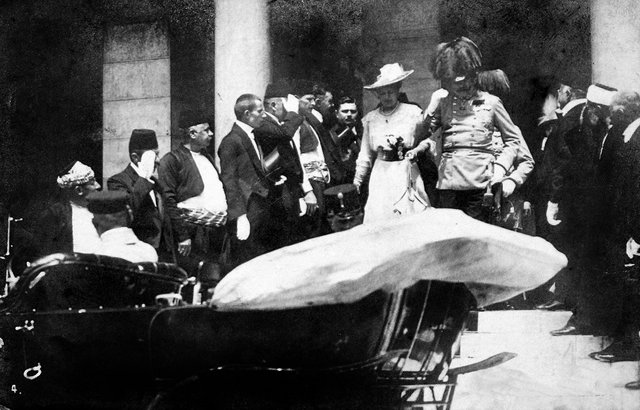
According to legend, World War I began in Sarajevo with a single bullet from a .380 calibre FN Model 1910 -- a bullet that tore through the throat of Archduke Franz Ferdinand von Hapsburg, the heir to Austria's throne, on 28 June 1914.
To this very day, many school children are taught that blame for the war may be pinned squarely on Gavrilo Princip, the Serbian terrorist who fired the pistol, and who started all of the dominos falling, falling, falling.
But is it fair to blame Gavrilo Princip for a World War? As if he were some bumbling waiter who had backed into a large stack of dishes, and started a world-wide food fight?
Certainly not.
In fact, on the morning of 28 June 1914, Princip did not act alone, nor did he fire "the first shot." Six members of The Black Hand, the terrorist organization to which Princip belonged, had lined the assassination route, all hoping for a chance to kill the archduke.
At 10:15 Nedeljko Čabrinović, one of the six, hurled a handgrenade at the archduke's automobile -- but it had a 10-second delay and injured people in a car to the rear.
After all the shock and clearing of smoke, the archduke and his wife might easily have escaped and stayed in doors.
But they did not. They decided to drive to hospital to visit their injured friends, and their driver, Leopold Loyka, managed to turn onto the wrong street -- Franz Josef Street. As if to turn around, he stopped the car only a short distance from the Schiller Cafe, where Gavrilo Princip stood with a pistol in his pocket.
As Princip approached, Loyka put the car in reverse, and the engine died. Trying to restart the motionless car, Loyka flooded the engine.
Thus, by some strange stroke of misfortune, the driver for the archduke and archduchess put them right under an assassin's gun. Only five feet from their car, Princip drew the pistol from his pocket, took careful aim at his targets and -- and the rest is history.
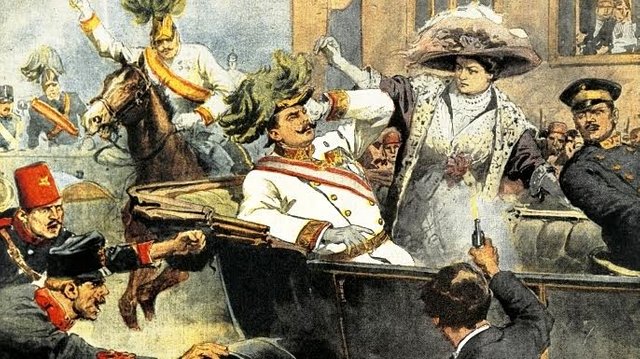
One certainly may blame Princip for what happened next (World War I).
But one might just as easily blame the driver, Leopold Loyka, or a faulty spark plug, or the archduke himself. What idiot notion inspired the archduke to return to the streets in an open car? Had he stayed indoors, as any reasonable person would, he and his wife might have lived, and the course of history might have been forever changed.
Or so we would like to think.
1914 Editorial Predicted Assassination Would Lead to World Peace
In 1914, it was not at all certain or clear that this shooting would lead to a declaration of war between Austria and Serbia. In fact the June 29 editorial column in the Vancouver Sun (Canada) predicted that the killing would lead to a safer Europe.

Franz Ferdinand was the heir to the throne of Austria, which was still ruled by his father, but he was recognized in diplomatic circles as the mastermind behind Austria's 1908 annexation of Bosnia -- an extremely aggressive and dangerous move that nearly led to World War in 1908.
“At the time," says the Sun, "the annexation of Bosnia caused a sensation in Europe and threatened to drag the powers into the oft predicted European war through Russia becoming involved with Austria in defence of the Slavs of Serbia.”
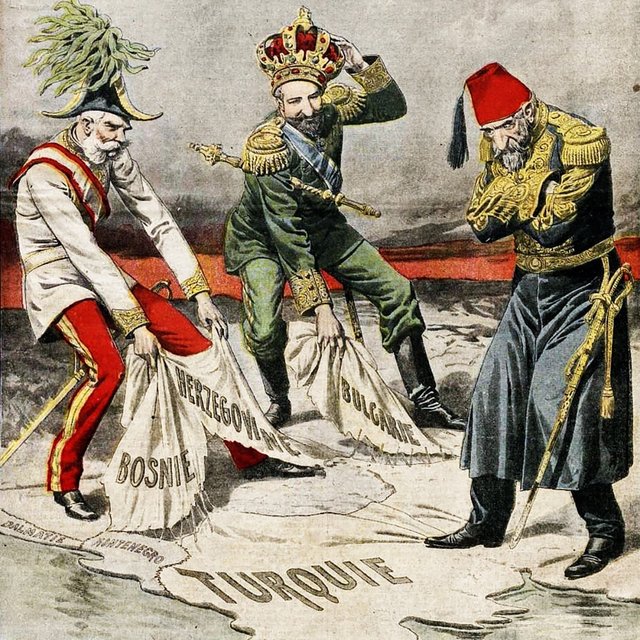
The editorial adds that Franz Ferdinand's “friendship for the German emperor also gave his enemies in Europe an opportunity to accuse him of favouring an aggressive policy, and it had been a fetish in the continental capitals that when he came to the throne there would be an end to the peace that had prevailed among great powers.”
Hence the Vancouver Sun's mistaken conclusion that his removal would mean peace for Europe.
Serbia vs. the "Greater United States of Austria"
In fact, the Hapsburg family --- and Archduke Franz Ferdinand -- deserve a much larger share of the blame for starting World War I than many people realize.
It goes beyond the archduke's ghastly decision to ignore basic security rules at Sarajevo on June 28.
Austria very definitely provoked the attack.
Between 1900 and 1913, Austria made every effort to reduce Serbia to a vassal state of the Austro-Hungarian empire, and when Serbia tried to break free in 1906 by trading with Bulgaria and France, Vienna responded by placing harsh economic sanctions. The makers of Vienna sausage refused to buy one of Serbia's main products: pork.
The result, between 1906 and 1913, was a bitter trade war between Austria and Serbia known as "The Pig War." It soon escalated into real hostilities.
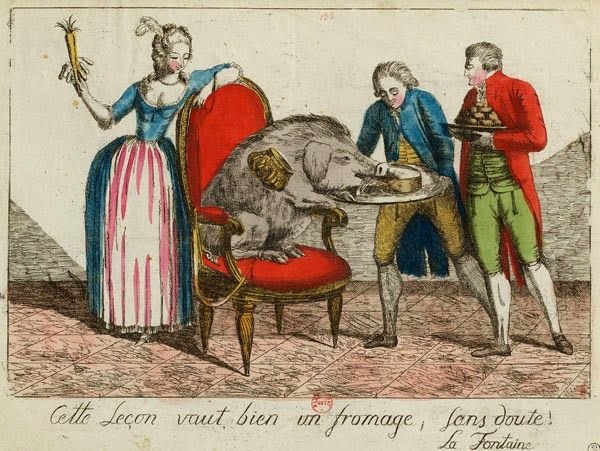
Franz Ferdinand appeared often in the newspapers as one of the main architects and promoters of a plan to break down trade barriers and create an Austrian-dominated federation of European states -- better known as a "United States of Europe" or (today) a European Union.
Today the seat of the European Parliament may be found in the city of Strasbourg -- the Imperial City of the Holy Roman Empire and home of the Hapsburg dynasty for more than four centuries (1262 - 1681).
This is not a coincidence. It is in fact the fulfillment of a plan drawn up long before World War I began.
Hapsburg plan for a European Union
Part of the Hapsburg family's vision for a new order in Europe centered on creating "The United States of Greater Austia" -- a federation of all the smaller states and ethnic minorities within the Austrian empire.
Archduke Franz Ferdinand asked Aurel Popovici to draw up economic plans and a map for the United States of Greater Austria in 1906.
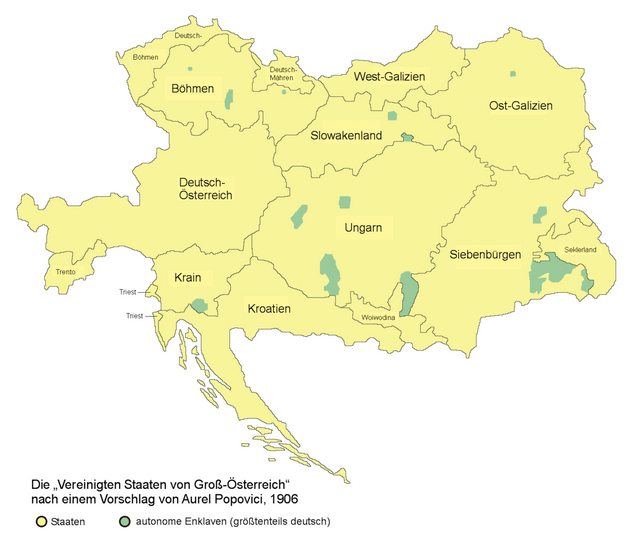
A close study of the economic plans that Franz Ferdinand and Mr. Popovici proposed made it clear to the Serbs and many others that the Austrians intended to dominate the economy of all member states through a central banking scheme. All the noises the Austrians were making about respect for ethnic diversity and religion were simply a front for seizing control of the economies of member states.
The Serbian nationalists who attacked Franz Ferdinand in Sarajevo knew this. They knew that the Hapsburg dynasty were attempting to expand their empire at the expense of Serbian independence and sovereignity. That's why they killed the heir to the Hapsburg throne: It was (in their view) an act of self-defense, and a blow aimed directly at the architect of the new European order that threatened to destroy their economy, their national identity and their way of life.
Serbian Puppetmasters
Who was it that organized the Black Hand, and gave their six foot-soldiers orders to kill the archduke and the archduchess?
The answer may be found in Norman Polmar and Thomas B. Allen's Spy Book: The Encyclopedia of Espionage (New York: Random House, 1998), which contains an article on "The Black Hand."
By 1914, the secret society known as the Black Hand was in fact a special branch of the Serbian Army's general staff. Specifically, the man who controlled the Black Hand and gave them orders to assassinate Archduke Franz Ferdinand at Sarajevo was none other than the Chief of Intelligence for the Serbian Army's General Staff: Col. Dragutin Dimitrijevic.
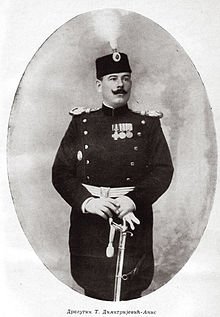
Clearly, the assassination of the heir to the Austrian throne was not accidental and not planned or arranged by a lone nut. The Serbian Army's intelligence staff itself had put six agents in place and carefully planned the shooting.
As the editors at the Vancouver Sun indicated above, they thought they were removing the man who posed the greatest threat of war in 1914.
To them, this was a simple case of retaliation for Austrian oppression that had begun with the "Pig War" in 1906 and the annexation of Bosnia in 1908. The Austrians had imposed martial law on Serbia in 1913, and the Serbian nationalists found this intolerable.
Later, at the trial of Gavrilo Princip and his associates, it became clear that the Serbs had fully informed the ministers at the Russian consulate in Sarajevo as much as a week before the shooting
The Russians (who are traditional allies to the Serbs) had been well aware of the assassination plot for more than a week, and they had chosen to say nothing to warn the archduke.
This helps to put into perspective what really happened at Sarajevo: It was the escalation of an economic trade war that had been very long in the making, and a knock-down fight between Austria, Germany, Russia, France and Britain over who should be boss of a hypothetically united Europe.
Given the historic vote on 27 June 2014 for the Ukraine to join itself to the the European Union (a choice strongly opposed by Russia), it would seem that such conflicts are still alive and kicking.
Everyone agrees it would be great to achieve World Peace. That's always been the goal.
But it seems that there is a perpetual, never-ending and on-going World War over who will be the boss of this new order.
The assassination at Sarajevo was only one small episode in an international struggle that continues to this day.
References
Library of Congress - The Assassination of Archduke Franz Ferdinand
The Great War
Wikipedia - World War I
Britannica - The Pig War
First World War - Who's Who - Gavrilo Princip
CNN - The man who started WWI: 7 things you didn't know
Welcome to a thought-provoking journey through history. Today, we're taking an in-depth look at the origins of World War I, one of the most important events that shaped our world. Going back in time, we explore the reasons that set the stage for this global conflict http://www.military-today.com/life/the_main_reasons_for_the_beginning_of_world_war_2.htm. Brace yourselves as we are about to unravel the complex web of circumstances and decisions that led to this devastating war. We will find out those reasons with the help of this website